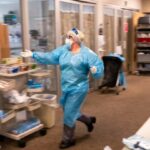By Jack Phillips
COVID-19 symptoms have now become more mild and are nearly indistinguishable from allergies or the common cold, often affecting the upper respiratory tract, a number of doctors have said.
They note that some of the notable COVID-19 symptoms, including a cough or a loss of taste or smell, are less common among patients.
“It isn’t the same typical symptoms that we were seeing before. It’s a lot of congestion, sometimes sneezing, usually a mild sore throat,” Dr. Erick Eiting, vice chair of operations for emergency medicine at New York’s Mount Sinai, told NBC News on Sept. 16.
“Just about everyone who I’ve seen has had really mild symptoms,” Dr. Eiting said, referring to urgent care COVID-19 patients. “The only way that we knew that it was COVID was because we happened to be testing them.”
A study published in The Lancet shows that symptoms for COVID-19 have become milder since the omicron variant emerged and supplanted the delta variant in late 2021. Hospital admissions have also declined since then, along with initial symptoms such as a loss of taste or smell, according to the paper.
“The SARS-CoV-2 variant of concern, omicron, appears to be less severe than delta,” the abstract states, noting that there has been a “lower rate of hospital admission during omicron prevalence than during delta prevalence.”
Dr. Dan Barouch, director of the Center for Virology and Vaccine Research at Boston’s Beth Israel Deaconess Medical Center in Boston, told NBC News that the mild symptoms are, in part, due to previous immunity.
“Overall, the severity of COVID is much lower than it was a year ago and two years ago. That’s not because the variants are less robust. It’s because the immune responses are higher,” the doctor said.
Several doctors who spoke to the network said COVID-19 now commonly starts with a sore throat.
Dr. Michael Daignault, an emergency physician in California, told the network that “especially since July, when this recent mini-surge started, younger people that have upper respiratory symptoms … 99 percent of the time they go home with supportive care.”
The upper respiratory tract includes the nose, nasal cavity, mouth, throat, and voice box. The lower respiratory tract includes the trachea, lungs, and bronchial tubes.
Dr. Grace McComsey, with Case Western University, said that with the onset of the sore throat, some COVID-19 patients had “a burning sensation like they never had, even with strep in the past.”
“Then, as soon as the congestion happens, it seems like the throat gets better,” she said, estimating that about 10 to 20 percent of patients lose their sense of taste or smell now.
COVID or Something Else?
“When people aren’t feeling well with some sort of upper respiratory illness, it can be difficult to ascertain whether it’s an allergy, cold, influenza, or COVID,” infectious disease physician and researcher Pritish Tosh of the Mayo Clinic told The Messenger.
“And there’s some clues that can help distinguish them, but sometimes it’s completely indistinguishable, especially if the symptoms are not very severe. If there is fever involved, it is not an allergy. However, you can have sneezing, a cough, and watery eyes with an allergy.”
Mr. Tosh said that “more severe infections, the kind that make it really hard to breathe, where you get really high fevers and it knocks you out for days and days—that is really unlikely to be a cold.”
“Now, we’re in the realm of influenza or COVID,” he said.
Mask Mandates?
The comments from doctors come as a number of hospitals across the United States have reimplemented mask mandates in recent weeks. Several hospitals last week moved to bring back face coverings because of what officials say is a rise in COVID-19 hospital admissions.
On Sept. 15, the Baystate Health system in Massachusetts announced that it would require masks for anyone entering patient rooms or patient care areas. That includes doctors, nurses, visitors, and patients, it stated.
In Pennsylvania, Mount Nittany Health stated on Sept. 14 that it would mandate employees to wear masks while engaging with patients. The mandate will run until Sept. 29, according to a statement cited by a local media outlet, but it doesn’t include a mandate for visitors or patients.
Around the same time, Cape Regional Medical Center in Cape May County, New Jersey, confirmed that it would also be reinstating a mask mandate. There’s no mandate for visitors or patients, officials told local outlets.
The new rules come weeks after several hospitals in upstate New York, Massachusetts, and California reimplemented masking, although some didn’t make face coverings mandatory for patients and visitors.
Data provided by the U.S. Centers for Disease Control and Prevention show that hospitalizations across the United States rose by 8.7 percent in the week ending Sept. 2. The total number of COVID-19 hospital admissions is still quite low compared to previous increases in hospitalizations.






